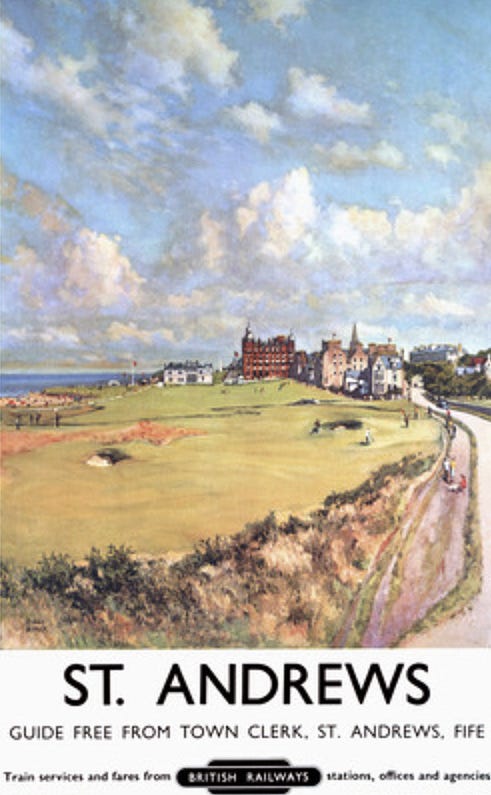On one of my first trips to The Open, more than 30 years ago, I bought a reproduction of a 1957 British Railways lithograph by James McIntosh Patrick that promoted train journeys to St. Andrews. I recently noticed an original poster selling for £3,000. My copy, purchased for a tiny fraction of that asking price, has given me pleasure for a long time, a reminder of one of golf’s special places.
From Dundee, Patrick (1907-1998) is regarded as Scotland’s foremost 20th century landscape artist. After studying at the Glasgow School of Art, Patrick produced etchings as a young man, then became known for his watercolors and oils, detailed works depicting his native country.
Patrick was known for including lanes or streets in his paintings, and he did so in the St. Andrews poster. In the case it’s the road on the 17th hole of the Old Course. The first and 18th holes are beyond, with town buildings on the right and the Royal and Ancient beyond. I’ve taken photographs of the same scene multiple times, including from the roof of the Old Course Hotel in 1999, but there is some magic in Patrick’s depiction. If that poster didn’t drive some tourism to Fife, during a time when you could play the Old Course for a song, it wasn’t the artist’s fault.
1957 poster by Scottish artist John McIntosh Patrick.
In recent months, Patrick’s lithograph has taken on added significance, becoming more than something to admire.
On Feb. 6, with an itch to hit some balls, I went to a driving range with heated stalls. I hadn’t been there for a while and was dismayed that the price of a bucket had gone up considerably since my last visit. (Their new launch-monitor gizmos must not have come cheap.)
Any winter golf in New England feels like a bonus, and these 50 shots were no different. As I went through my bag, though, my right eye started feeling a little funny, the vision obscured in the very bottom of view. I didn’t think much of it, but that evening it got a little worse. When I turned off the bedside lamp, the light lingered in that eye in after I’d closed it. The next morning, the dark curtain in had edged upward. By the time I was in my ophthalmologist’s office in mid-afternoon, I had very little sight in the eye that was acting up. Forget reading the smaller letters on the eye chart—I could only see, just barely, the giant E on top. The joy of seeing so beautifully after having cataract surgery on both eyes in the fall of 2020 was replaced by dread. My thoughts went lots of places, to the young, visually impaired man in my neighborhood walking with his white cane and to the first stories I read in Golf World about the national blind championship.
As a specialist confirmed a bit later that day, I had a fully detached retina. Twenty-four hours later, I was riding home from a surgical center, repair made and gas bubble in the eye to promote healing. When the patch came off the next day, I looked like I’d gone 12 rounds with somebody very mean and very strong. The next order of business was to rent a chair to make it easier to do the face-down position for eight to 10 hours a day for several weeks so that the bubble could do its job in getting the retina to behave. “Straight down at the earth,” my ophthalmic surgeon implored in his instructions. When I was tired of watching television reflected into a small mirror on the chair’s attached shelf—a godsend, because I found reading for any length of time while in that tedious position untenable—I played plenty of rounds in my head, breaking par at any number of famous courses.
Not far away from the rental chair was the St. Andrews poster. In the weeks and months after the operation to re-attach the retina, as I anticipated working my fourth Open at the Old Course and having a right eye that worked well again, I often used the text below Patrick’s painting to gauge my recovery. From my couch a dozen feet away, the bold and large “St. Andrews” was easy enough to make out. The smaller copy below was a different story. At first, making out “Guide Free From Town Clerk, St. Andrews, Fife” with my right eye was impossible. Now, I usually can read it.
It was nine weeks after surgery until I swung a club. The gas bubble completely blocks your vision for a while. As it diminishes in size, it appears as a black circle in the lower field of sight, first the size of a nickel, then a dime, then, when the gas is almost exhausted, as a speck. I was wary of playing golf until it was almost gone and flinched when blasting my first shot out of the sand because my surgeon was the ultimate realist when talking about recovery and the chances of it detaching again. With each appointment that revealed a stable retina, his outlook brightened and so did mine. On my most recent checkup, in late June, I got another good report. I was 20/40 in my right eye, an improvement from 20/80 at the previous exam. There is some distortion that likely won’t go away, but given the state of my vision on Feb. 7, I’ll take it, and keep hoping for no bumps in the recovery road.
Yesterday morning, I rode into St. Andrews with a colleague. The approach, with the ancient links and town looming, always stirs the golf soul. In the afternoon, which was mild and partly sunny, I took a walk—down by the West Sands, up into town and eventually out on the land where golf has been played for hundreds of years. When I got out to the Road Hole, taking in the scene as Patrick had 65 years ago, I stood for a good long while, savoring what I could see.




Thanks so much, John.
Beautiful story, Bill. Enjoy the views at St. Andrews this week.